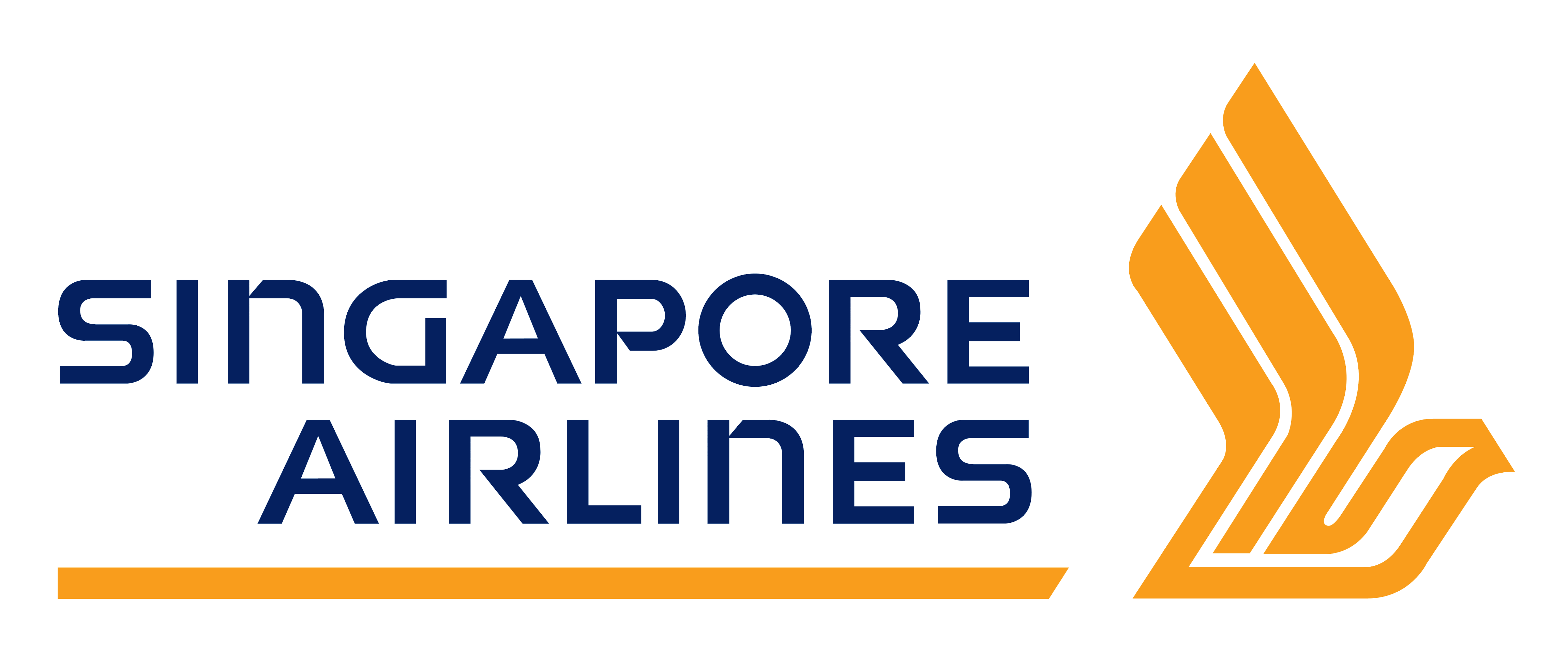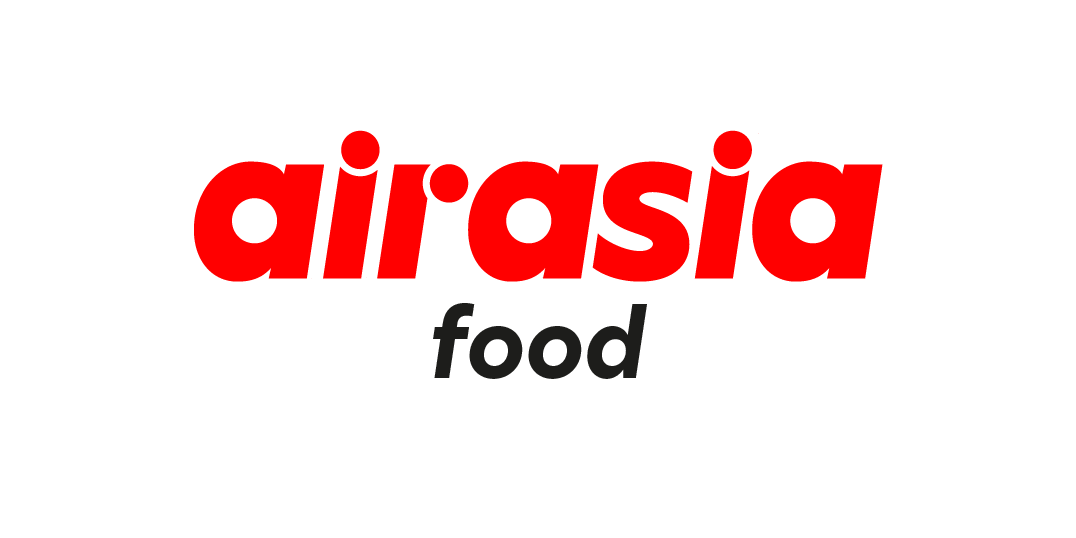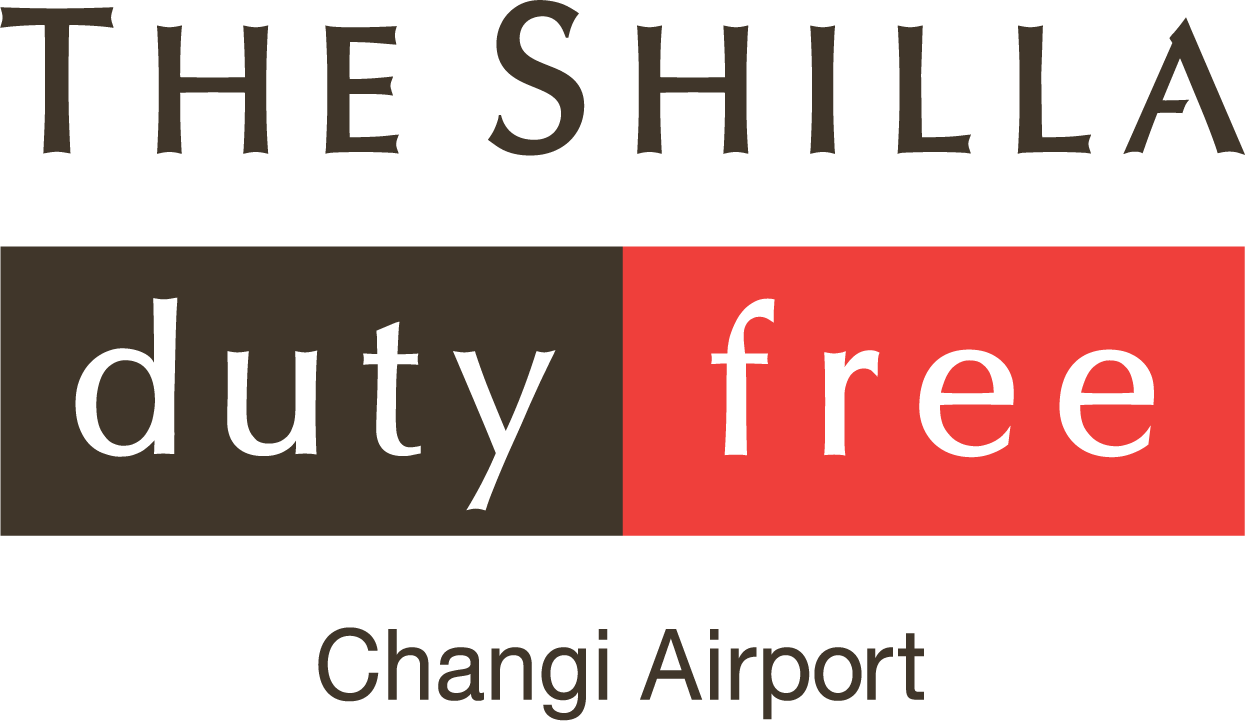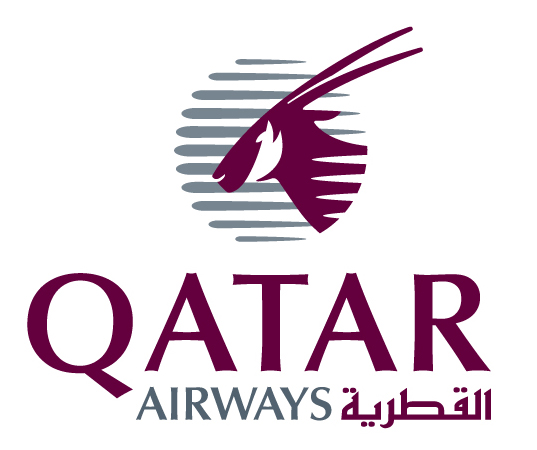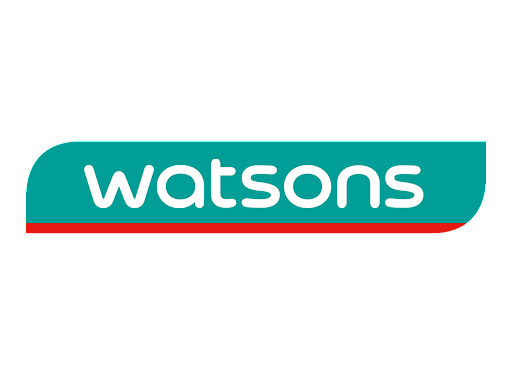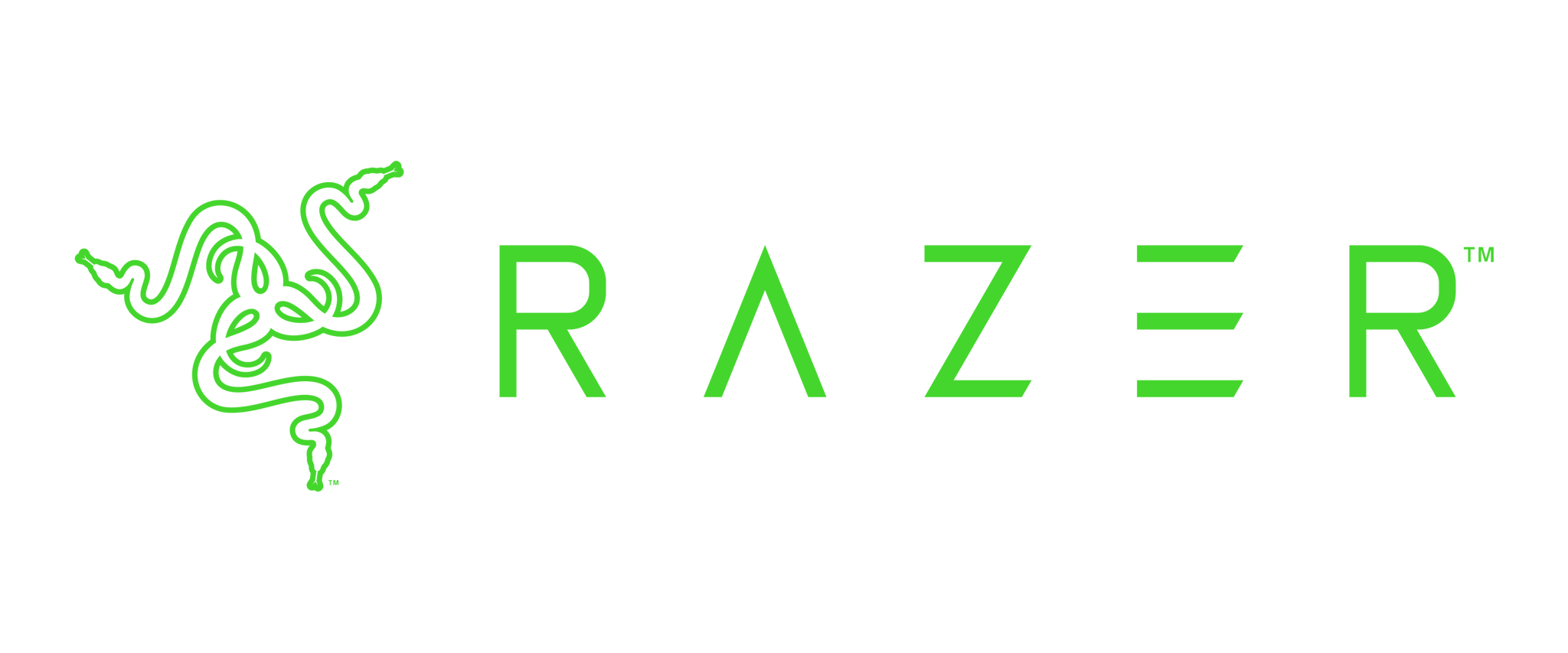If you’re wondering the types, costs, and contributions of various airline carbon offset programmes, we’ve deep dived into 10 popular airlines for you!
How do carbon offset programmes work? We’ve put together an informative guide to carbon offsetting but in short, the extra money you pay during your flight checkout actually contributes to eco projects and organisations around the world!
Travel & Carbon Emissions Series:
• What is Flight Carbon Offset & How Does it Work? 💨
• Carbon Offset Programme Types, Costs & Contributions ✈️
• Reducing Carbon Footprint: Flight, Car, Bus or Train? 🚂
Different airlines calculate carbon offset rates differently and generally there are four methods to determine how much you pay to offset carbon:
- Project type 🌳
- Airfare class 💺
- Airfare class + Project type 💺🌳
- Flat rate 🔒
Project type 🌳: Different eco projects need different costs to operate and you can choose the project that you’re most passionate about to contribute to. If you care about reforestation, then go ahead and pick that!
Airfare class 💺: The higher your airfare class, the more emissions you create. That’s because Business Class configuration has a lower seat density and won’t be able to fit as many passengers as the Economy Class section. That’s why Business Class flyers have higher carbon footprint per passenger compared to Economy Class flyers for the same flight, hence a higher cost to offset carbon.
Airfare class + Project type 💺🌳: Each project is further segregated into airfare classes. So if you’re flying Economy and picking a reforestation project, you’ll be paying lesser carbon offset costs than a Business Class flyer on the same flight who’s picking reforestation too!
Flat rate 🔒: No segregation by Project type or Airfare classes, anyone who wishes to offset their carbon will pay the same flat rate!
To further look at how much each airlines offer in their carbon offset programmes, we’re using a return trip from Singapore to Sydney – a journey that covers a total of 12,600km.
Note that even though the distance is similar, each airlines will have a different amount of carbon emissions because of the various fleets of aircrafts; some aircraft might be more fuel-efficient than others, hence less fuel burn and emissions.
Without further do, we’ve rounded up 10 popular airlines that offer carbon offset programmes, together with their carbon offset rates and types of eco projects you’ll be contributing to:
1. Air Canada
Emissions based on: Project type 🌳
Average cost per tonne of CO2: ~S$21 to ~S$25
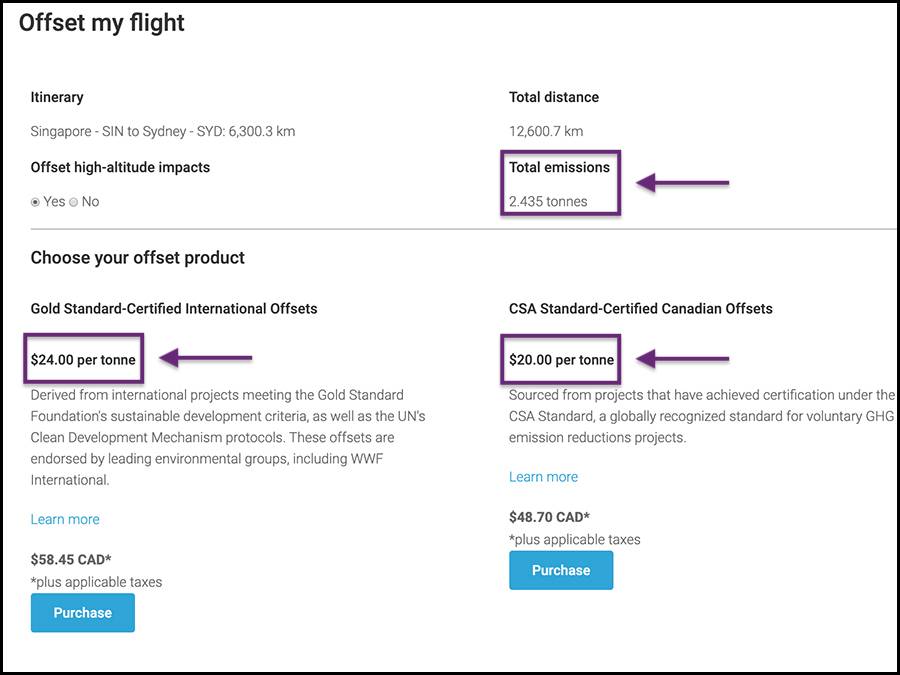
| Rate Type | CO2 Emissions | Cost |
| Standard (VER+ Standard-Certified Canadian Offsets) | 1 tonne | C$20 (~S$21) |
| Gold (Gold Standard-Certified International Offsets) | 1 tonne | C$24 (~S$25) |
Starting off this list is Air Canada, who has partnered with Less Emissions to reduce the environmental impact of air travel. Air Canada offers different rates according to the type of certification each project holds:
With the example of a return flight from Singapore to Sydney, it costs you C$48.70 (~S$50) for Standard and C$58.45 (~S$60) for Gold to offset your whole trip.
At the time of writing, your money goes to building a landfill gas collection plant in Canada if you choose Standard. On the other hand, Gold moves your contribution to Thailand, where a wastewater plant would be built to reuse energy from waste generated from a starch plant in Nakhon, and China, where solar powered stoves would be built to provide some 48,000 villagers in Nanjing. Latest projects are listed here.
2. Delta Airlines
Emissions based on: Project type 🌳
Average cost per tonne of CO2: ~S$9 to ~S$14

| Project | CO2 Emissions | Cost |
| Guatemalan Conservation Coast Project | 1.145 tonnes | US$7.44 (~S$10) |
| Kasigau Corridor Redd+ Project | 1.145 tonnes | US$9.16 (~S$12) |
| Southern Cardamom Redd+ Project | 1.145 tonnes | US$9.16 (~S$12) |
| TIST Program in Kenya | 1.145 tonnes | US$11.45 (~S$16) |
At first glance, Delta Airlines’ carbon offset programme may look similar to Air Canada’s, but it doesn’t show you the rate per tonne. Instead, you only see the final cost.
Delta’s website claims that “the cost to offset your flight is based on the resources required and may vary by project“. One more thing to note is that the projects don’t seem to have the certifications that Air Canada has.
Delta Airlines’s approach is good if you want to know where your money is going to, but you’re not bothered by the mechanics of it. However, as a consumer, it’s most likely that you’d want to know more about the cause you’re contributing to.
3. Air New Zealand
Emissions based on: Airfare class 💺
Average cost per tonne of CO2: ~S$22

| Class | CO2 Emissions | Cost |
| Economy | 0.92 tonnes | NZ$23.40 (~S$21) |
| Premium Economy | 1.47 tonnes | NZ$37.44 (~S$33) |
| Business | 2.67 tonnes | NZ$67.86 (~S$60) |
As mentioned earlier in the introduction, higher airfare classes require higher costs to offset carbon.
With Air New Zealand, where is this money going to, you ask? It goes to ClimateCare, an organisation with over 150 years in the global carbon market. Specifically, it contributes towards forest restoration projects in six locations throughout New Zealand.
4. Cathay Pacific
Emissions based on: Airfare class 💺
Average cost per tonne of CO2: ~S$3

| Class | CO2Emissions | Cost |
| Economy | 1.28 tonnes | HK$24.60 (~S$4) |
| Premium Economy | 1.59 tonnes | HK$30.75 (~S$5) |
| Business | 1.91 tonnes | HK$36.90 (~S$7) |
| First | 2.55 tonnes | HK$49.19 (~S$9) |
Cathay Pacific follows a similar model to Air New Zealand. It charges rates according to class type – their rate per passenger is ~HK$19.33 (~S$3) per tonne of CO2.
I wasn’t able to plug in the flight from Singapore to Sydney, so I’ve got the above results from their home airport in Hong Kong instead.
At the time of writing, Cathay Pacific has partnered with ClimateCare and FirstClimate. The calculator doesn’t give you a choice as to which projects you want to contribute to, so it’s assumed that Cathay Pacific, ClimateCare, and FirstClimate have an internal agreement about how much money each project is going to need. A little transparency and agency of choice for the customer would be nice though.
5. China Airlines
Emissions based on: Airfare class 💺
Average cost per tonne of CO2: ~S$14
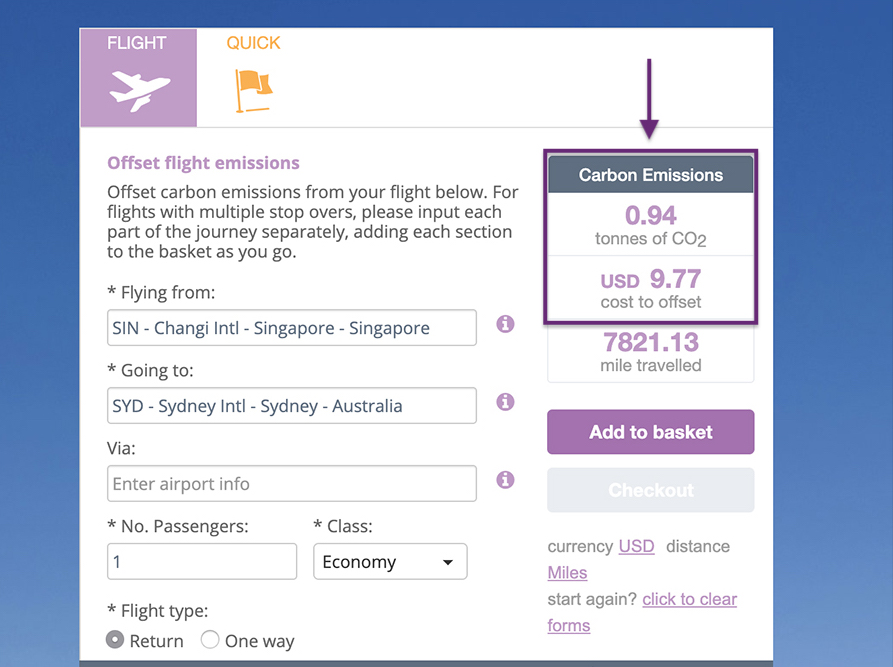
| Class | Emissions CO2 | Cost |
| Economy | 0.94 tonnes | US$9.77 (~S$13) |
| Business | 1.89 tonnes | US$19.54 (~S$27) |
China Airlines keeps in with the theme of charging carbon credits to passengers by class. According to my calculations, each passenger pays about ~US$10.40 (~S$13) per tonne of CO2.
China Airlines has also partnered with ClimateCare but they did not specify which projects your money goes to. Much like Cathay Pacific, a little transparency and agency of choice for the customer goes a long way.
6. EVA Air
Emissions based on: Airfare class 💺
Average cost per tonne of CO2: ~S$14

| Class | Emissions CO2 | Cost |
| Economy | 0.75 tonnes | USD$7.80 (~S$11) |
| Business | 1.51 tonnes | USD$15.61 (~S$21) |
Hold up, EVA Air’s calculator looks exactly the same as China Airlines’ but EVA Air has lesser carbon emissions – why?
Though passengers on both airlines are subjected to the same ~US$10.40 (~S$14) per tonne of CO2 rate, EVA Air probably has a more fuel-efficient fleet than China Airlines, hence the lower emissions and offset cost.
EVA Air also partnered with ClimateCare for their carbon offset programme. However, like China Airlines and Cathay Pacific, there’s no information about which project your money goes to.
7. Japan Airlines (JAL)
Emissions based on: Airfare class + Project type 💺🌳
Average cost per tonne of CO2: ~S$12 to ~S$168

Kumamoto: Logging Promotion Project in Oguni
| Class | Emissions CO2 | Cost |
| Economy | 1.89 tonnes | JP¥25,515 (~S$317) |
| Business | 5.47 tonnes | JP¥73,845 (~S$919) |
| First | 7.54 tonnes | JP¥101,790 (~S$1,266) |
Rimba Raya Biodiversity Reserve REDD+, Indonesia
| Class | Emissions CO2 | Cost |
| Economy | 1.89 tonnes | JP¥1,796 (~S$22) |
| Business | 5.47 tonnes | JP¥5,197 (~S$65) |
| First | 7.54 tonnes | JP¥7,163 (~S$89) |
Japan Airlines’ (JAL) carbon offset programme offers travellers to offset their emissions by airfare class under different projects.
I’m not sure why the emission figures are inflated. The likely explanation is that these figures are based on JAL’s historical data and that its emissions are unique to its fleet and operations.
Even then, the rates per tonne for each project seems high as well; the Logging Promotion Project in Oguni is going for JP¥13,500 (~S$168) per tonne of CO2, while the Rimba Raya Biodiversity Reserve in Indonesia is only JP¥950 (~S$12) per tonne of CO2.
8. Lufthansa
Emissions based on: Airfare class + Project type 💺🌳
Average cost per tonne of CO2: ~S$28 to ~S$730
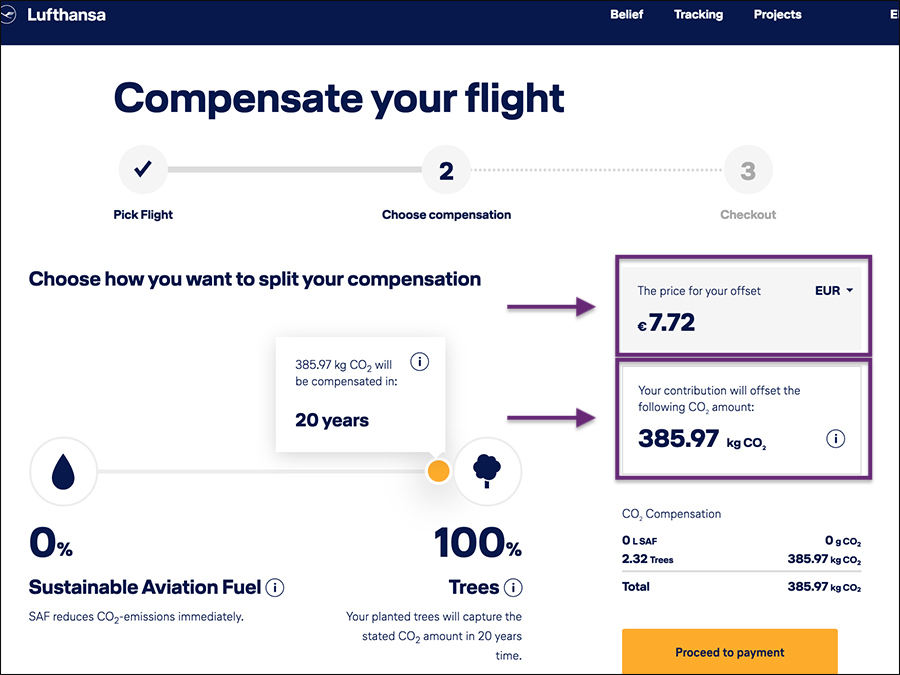
| Class | Emissions CO2 | Cost (SAF) | Cost (Trees) |
| Economy | 0.39 tonnes | €188.49 (~S$282) | €7.72 (~S$12) |
| Premium Economy | 0.54 tonnes | €263.89 (~S$422) | €10.81 (~S$16) |
| Business | 0.83 tonnes | €405.26 (~S$632) | €16.60 (~S$24) |
| First | 1.23 tonnes | €598.47 (~S$896) | €24.51 (~S$36) |
Lufthansa’s calculator is also interesting because of the similar offering as JAL to offset emissions by airfare class under different projects – a choice between planting trees or buying Sustainable Aviation Fuel (SAF).
According to Lufthansa, SAF is roughly 3 times more expensive than regular fuel because of the logistics and refining process, and is compounded by the low demand. However, using it emits up to 80% less CO2!
But if you don’t have that kind of money, you can pay less for a tree, opting to use time instead of money as a resource.
It’s also quite interesting that Lufthansa’s calculator lets you slide the ratio between paying for fuel and trees, and I appreciated the fact that nearly every figure has an explanation tooltip. By my calculations, each passenger pays around €488 (~S$730) for a tonne of CO2 emitted via SAF, while planting trees costs €19.92 (~S$29) for a tonne of CO2 to be absorbed.
9. Qantas Airways
Emissions based on: Flat rate 🔒
Average cost per tonne of CO2: ~S$12

| CO2 Emissions | Cost |
| 1.04 tonnes | A$13.74 (~S$13) |
The Qantas calculator is fairly straightforward. You simply key in your departure and arrival destinations, and it calculates the carbon emissions regardless of class type.
The different causes in the “Choose a cause to support” section are forest restoration projects in Australia and Papua New Guinea, and no matter which cause you choose, it doesn’t affect the cost of your carbon offset.
10. United Airlines
Emissions based on: Flat rate 🔒
Average cost per tonne of CO2: ~S$14

Just a disclaimer: I wasn’t able to plug in the flight between Singapore to Sydney on United’s calculator because they don’t serve that location from Singapore. I chose the next best thing, which was Singapore to Los Angeles.
Fortunately, their calculator is straightforward just like Qantas. No segregation by airfare class; everyone pays a flat rate.
| CO2 Emissions | Cost |
| 1.9 tonnes | US$19.04 (~S$26) |
United Airlines’ carbon credit programme is dubbed Eco-Skies and they’ve partnered with Conservation International, an organisation that specialises in forest conservation. For United Airlines’ case, this conservation is for the forests in Peru.
What About Other Popular Airlines?
While the airlines we’ve listed above allow you to calculate your carbon emission and offset costs, some airlines don’t have these carbon emission calculators. You’re required to input your flight booking number first, before you can check your flight’s carbon emission and costs. Some of these popular airlines include:
You might be wondering where’s our flagship carrier in all of this? Good news though, some airlines are still monitoring their CO2 and working on their carbon offset programmes to launch soon!
- Singapore Airlines (2021)
- AirAsia (TBA)
- Malaysia Airlines (TBA)
Which Carbon Offset Programme is The Best?
I’ll admit, this isn’t your typical “which is cheapest?” article because that’s not the point. What usually happens is you go to travel booking websites to find yourself the cheapest flight and then make a decision IF you want to contribute carbon credits towards it.
Furthermore, there are so many airlines offering various eco projects, and this guide serves as a breakdown should you choose to fly with any of these airlines.
More than anything, as a passenger, you should know the rates you’re paying for, and which project your money goes to. Since much of these projects are in foreign currency, you’ll also want to make sure that you pay for it with your YouTrip card to utilise YouTrip’s Wholesale Exchange Rates!
Read: 8 Unique Eco-Friendly Hotels in Southeast Asia
Read: Australia Wildfires: Cheaper Travels But At What Cost?
Read: What is Flight Carbon Offset & How Does it Work?
Read: 5 Best Ecotourism Destinations You Should Visit
Read: Sustainable Travel Guide: 8 Tips to Become a Green Traveller
Enjoy a travel experience with no fees worldwide!



























